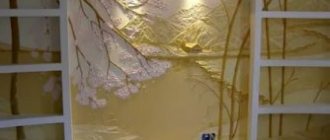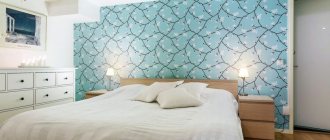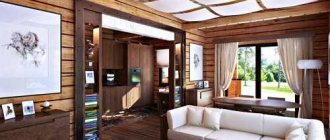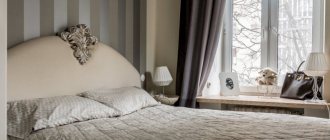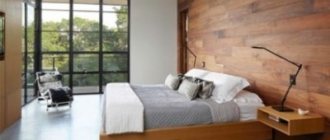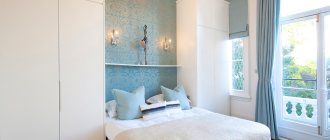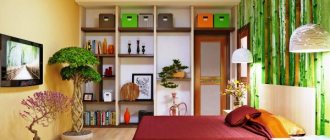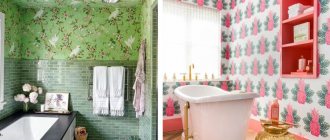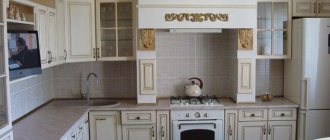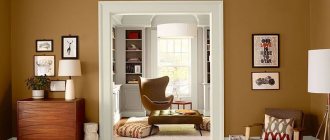Leather wallpaper: characteristics of natural material
Our ancestors hung the skins of killed animals in their huts to protect them from cold and bad weather.
Time has passed, but modern people still have the habit of decorating the walls of their homes with leather. Smooth or textured, serving as a background or a bright accent, it has long made its way into residential interiors and settled there, apparently for a long time. Fortunately, the flexibility of the material allows them to be bent and designed into any configuration with rectangular or radius corners. They have a number of advantages, including safety for humans and environmental friendliness, fire resistance and durability, moisture resistance and easy maintenance.
Leather wallpaper for walls photo
https://www.youtube.com/watch?v=ym5XmOM2_GQ
Properly tanned leather can last for several centuries, as evidenced by fragments of leather interior decoration of medieval castles. The process of tanning leather is long and labor-intensive - it is soaked, cleaned, treated with tannins, dyed, and pressed. Therefore, the price of such material cannot be low.
To satisfy the demand of a wide range of buyers, manufacturers of building materials come up with various ways to reduce the cost of products or offer high-quality substitutes. This is how leather-look wallpaper appeared - a high-quality imitation of genuine leather, but more affordable.
Snakeskin wallpaper in the interior photo
As you already understand, modern technologies can imitate any color and texture of skin, from bovine to crocodile or snake. And they do it completely believably. This decor is not simple; it obliges the rest of the furnishings to match the chosen style. There is a fine line here, after crossing which the interior goes from the category of fashionable and modern to the category of tasteless and rough, the comfort of the hearth disappears, and in its place comes the brutality of a primitive hut.
- It’s rare that all the walls of a room are covered with leather wallpaper. This is a decor that is serious enough to cover the entire room with. As a rule, one wall is allocated for leather finishing: in the office or living room - in the relaxation area near the sofa or armchairs, in the bedroom - at the head of the bed, in the hallway it is a wall free from furniture.
- Fragments.
They are also used in fragments, especially for wallpapers imitating the skin of reptiles, which emit quite strong energy. For example, wallpaper with imitation snake or crocodile skin looks strict and is used to place the main accents in the room. Reptile skin wallpaper photo - Style directions. Natural leather colors without obvious shine, especially the type of carriage screed, are well suited for finishing interiors in a classic style, bedrooms, and accent areas of the living room. Python skin will emphasize the business seriousness of the office. Textured, voluminous finish will fit perfectly into a palace or English style. Light leather will be an organic complement to modern styles (loft, modern), and wallpaper with zebra or leopard print will be useful for interior decoration in African style. Good lighting, large framed mirrors, wooden or leather furniture will complement the appropriate interior.
Decorators never tire of using leather-look wallpaper when decorating fashionable interiors. But they do it competently and wisely. Non-professionals can only experiment and apply a finish that is quite difficult from the point of view of perception in small areas of the room, where the annoying print will not be visible all the time.
Initially, designers actively used leather in the decoration of hotel lobbies, restaurants and luxury homes. Today, leather is increasingly used in decorating residential premises of ordinary apartments, and the popularity of new comfortable finishing materials, of course, contributed to this.
Leather-like surfaces can be combined with a variety of materials and incorporated into different styles. The skin is emphasized by natural materials (wood, stone), set off by shiny metal and glass, and glamorous elements make it even more luxurious.
The main thing is not to create a feeling of satiety
Decorative plasters “under the skin” are essentially masses that hold their shape well. Using special tools, stencils and application methods, you can give the plaster a texture, and additional dyes, varnishes and glazes will bring the surface to a realistic look. And here it’s up to you to choose whether you want “cow skin”, “crocodile skin” or “python”.
Among the textured plasters, from which you can create a “skin-like” effect, you can find acrylic or vinyl based materials with the addition of marble, sand and other natural components.
But the most unimaginable modern material is Loggia Plasma 3D (pictured). The fact is that with it you can create absolutely any texture, including a very massive one, with deep cracks, for example, and at the same time the resulting surface is so durable that this plaster can be applied not only to the wall, but also to the floor, or, for example , on the countertop or cabinet fronts.
Well, after creating a specific texture “like the skin” with the help of finishing coatings (varnishes, glazes), you can give the surface a very realistic “wild” color or, conversely, a fantasy one.
Drawing options
Now let's move on to the drawings that are applied to the wallpaper. There is a wide variety of them, among which you can always choose something to suit your interior. Let's look at the main categories:
- Wallpaper imitating python skin. This option has one serious advantage over others - the scales are unevenly spaced and have volume, which gives the room a certain dynamism. This is an excellent option for respectable interiors, where you need to emphasize the financial viability of the owner. Such wallpaper is also suitable for marine interiors.
- The second popular coating is imitation zebra skin. For those who love minimalism and monochrome, this is a real find, becoming a highlight in such interiors. Such wallpapers will also come in handy in animalistic designs. Since they are restrained in color, they are able to withstand proximity to bright and even variegated colors. This wallpaper texture will also fit well into a loft-style interior.
- The third popular option is leopard print, found almost everywhere - on clothes, shoes and accessories. It will look no worse in the interior. Leopard wallpaper is not only an attractive and spectacular option worthy of luxury interiors, but also gives a feeling of comfort and coziness. Complemented with upholstered furniture and various accessories made from bright soft fur, the interior will turn out to be predatory and modern.
- It is impossible not to mention crocodile skin, so popular in Europe, which invariably adorns the walls of English offices. She has a slight touch of bad taste and at the same time a little rude. This is a strong, stylish and expensive solution suitable for rooms intended for important business meetings.
- Another option - leather embossed with silver or gold - is optimal for palace interiors or rooms decorated in a palace style. This is modern style and antique luxury rolled into one.
Wall finishing materials made of leather
This material is distinguished not only by its moderate price, but also by a more humane manufacturing method. Leather-look wallpaper consists of several layers and consists of a paper or non-woven base and a top layer on which a pattern and even embossing is applied.
- Vinyl wallpaper on paper basis. It seems that there is an environmental component, the wallpaper should breathe, but the top vinyl layer negates all the beneficial characteristics of the paper. Vinyl gives a realistic picture and texture that imitates leather, but the walls stop “breathing.”
- Pure paper wallpaper, duplex, consisting of several layers of paper (base and top layer) - they are vapor permeable, but the realism of the image leaves much to be desired, although this production method allows for light embossing on the surface.
Leather wallpaper photo - Paper wallpaper with acrylic coating - a layer of foamed acrylic is applied to a paper base, which, due to its porous structure, allows the walls to “breathe”. Such wallpaper can be wiped with a damp sponge and glued in rooms with high humidity. This is a kind of intermediate option between the previous two types - unlike paper, acrylic wallpapers are more durable and wear-resistant, but in comparison with vinyl they are inferior in aesthetic characteristics.
- Leather wallpaper for walls on a non-woven basis.
The best base for wallpaper, which has increased density, wear resistance and fire safety. The non-woven layer is thick, so it can hide small cracks in the base, and this wallpaper is easy to glue. In decorative terms, they are also more interesting - such wallpapers can depict not only the color of the animal’s skin, but also recreate its structure. The deep relief pattern looks realistic and natural. Wallpaper under the skin photo - Self-adhesive wallpaper with a leather look is a budget option for single-layer wallpaper based on PVC film. They are thin, not voluminous - they have a similar color, but do not convey the structure of the skin at all.
Vinyl coating provides the most believable texture, but debate about the harmfulness of this layer and the emitted formaldehyde vapors is still ongoing. Although manufacturers are doing everything possible to reduce the negative impact of the material on human health.
The easiest way to imitate genuine leather wallpaper is to choose vinyl wall covering. The varieties of colors and textures that can be embodied on vinyl are very diverse, and most importantly, such vinyl wall coverings look incredibly realistic. Vinyl wallpaper is made in a special way using an embossing procedure.
It is very convenient that in terms of the method of gluing, vinyl wall coverings are absolutely no different from the usual paper ones we are used to. They are glued using glue, which takes a long time to dry well, but they stay on the walls for a long time. The whole difficulty of repairing vinyl wallpaper lies in the correct choice. Leather-look wallpaper in a roll looks one way, but on the wall it looks completely different.
Decorating walls with leather is an expensive pleasure that wealthy people can afford both before and today. Indeed, leather was used to decorate the walls of rooms in Ancient Rome and today, at the beginning of the new millennium, this material is gradually reaching the peak of its popularity.
READ MORE: Layout of a bathhouse measuring 4x6 - washing and steam room separately 65 photos plan of an indoor room with an area of 4 by 6 drawings and diagrams of options measuring 6x4
Almost every owner strives to furnish his room or apartment, in general, with natural ingredients, to which the skin is directly related.
Some color and structure options for leather tiles are shown in the diagram.
Many experts advise to be careful when using leather elements in the interior. For this process, it is better to invite a professional designer, since even expensive and cozy material in excess can spoil the interior of the room.
Decorating walls with leather is an expensive pleasure that wealthy people can afford both before and today. Indeed, leather was used to decorate the walls of rooms in Ancient Rome and today, at the beginning of the new millennium, this material is gradually reaching the peak of its popularity.
- Wallpaper. This is a unique product that has excellent noise insulation and heat protection properties. In addition, the material has a fairly large range of colors and a wide range of relief. Every owner who wants to buy leather-like wallpaper for walls should know that this is a unique decorative device that creates unique comfort.
- Panels. New finishing elements that have excellent insulating, performance and decorative characteristics. The panels are easy to install and can be an additional design element.
- Leather tiles. Produced in square or rectangular design. It is, like other leather products, a luxury item that can both decorate a room and create additional insulation. Leather tiles are a beautiful and soft finishing material that creates excellent comfort in the room.
Red
Red wallpaper that imitates leather is best used for spacious rooms. Looks good paired with white or ivory.
An obvious choice for independent, liberated and freedom-loving people. In an apartment where white wallpaper predominates, you can safely notice that its owner is a successful and self-confident person.
The photo shows leather-effect wallpaper in white in a bathroom interior.
Brown
It can be warming at home or, on the contrary, official and strict. Any room in this color will look truly elegant and expensive, and your stay in it will be truly comfortable.
The photo shows the interior of an office with brown leather wallpaper on the walls.
Black
Will never leave anyone indifferent. This wall decoration carries the symbolism of superiority, efficiency and rigor.
The main point when choosing this type of wallpaper is the choice of material with a suitable texture. After all, their wear resistance and appearance depend on this.
The most common are vinyl wallpapers on a non-woven base with a relief texture that look like genuine leather. In addition, they are easy to use and do not require special care. They do not lose their original appearance for a long time.
There is a cheaper option - paper wallpaper. They have a leather pattern on them, but it does not match the texture of the leather. They are also very wear-resistant and durable. Multilayer paper wallpapers look more natural, repeating not only the pattern, but also the texture. But paper-based wallpaper is not as practical as non-woven vinyl wallpaper.
• the plot should be combined with the overall style of your room. Any leather-look wallpaper will look great in a modern interior; if you prefer classics, then you should try to choose the right option;
• when choosing wallpaper, you need to take into account the lighting factor;
• the room in which such wallpaper is planned also plays an important role. In order not to create the opposite of the desired effect;
Leather wallpapers are replete with a variety of themes, the most common are: snake skin, zebra skin, leopard print, crocodile skin. Each of them, correctly selected, can give your interior the effect of luxury and wealth.
Material of manufacture
Leather-look wallpaper will always have a multi-layer structure - a base and a top decorative layer on which the design is applied.
In this case, the surface of the last layer can be either smooth or textured. Depending on the base material, the following types of battles are distinguished:
- Paper. This is the most affordable option. The canvases are several layers of fairly thick paper. Due to the use of natural material, such wallpapers have high vapor permeability. Your walls will “breathe”, which means they are not afraid of the formation of mold or mildew. The surface of all-paper wallpaper will be smooth, and the design itself will not have a high level of realism. And in terms of strength and moisture resistance, they will be inferior to vinyl or non-woven products. This finish can only be used in dry, well-ventilated areas. Also, do not forget that paper does not retain color fastness well when exposed to ultraviolet radiation. To provide higher performance and decorative characteristics, a thin layer of vinyl can be applied to the paper base. Such a surface will be more resistant to moisture and sunlight. It becomes possible to make the decorative layer embossed and give it a slight shine, which overall makes the pattern more natural;
- Vinyl. They are distinguished by high aesthetic qualities. The pattern and plot can be conveyed as realistically as possible. In this case, polyvinyl chloride is used as a base. Vinyl wallpaper is highly durable, lightfast, and moisture resistant. If the surface has been additionally coated with varnish to impart a decorative shine, this will increase the service life of the coating as a whole. However, despite all the advantages, do not forget that vinyl is a material that does not allow air to pass through. Only rooms with a good level of ventilation can be covered with such wallpaper;
- Non-woven. Such wallpapers are the most expensive. But their cost is fully justified by both operational characteristics and high aesthetic indicators. The coating is moisture resistant. Wallpaper can be washed repeatedly with a damp cloth or sponge without harming the surface. The interlining is very dense, it does not stretch or distort during gluing, which makes it possible to maintain the exact geometry of the pattern and fit the canvases together as accurately as possible. The material is breathable. A satin pattern can be applied to its surface. Also, the surface can consist of matte and glossy areas at the same time;
- Self-adhesive. Such wallpapers are made on the basis of PVC film. But unlike the three previous types, they are single-layer. This makes the coating impractical and not durable. The quality of the drawing itself also leaves much to be desired; one can only dream of its realism. And if you choose self-adhesive wallpaper of dubious quality, there is a high probability that over time they will begin to peel off randomly.
- Wallpaper can also be made to order from really natural ox skin, which is subsequently embossed. Such wallpaper can imitate the texture of crocodile skin, python skin, and many others. They are produced not in the form of roll material, but more often in the form of sheets, which still need to be skillfully combined. The cost of such a product will be very high, and in this case there can be no question of humanity.
Brick wallpaper
“Wallpaper with brick imitation can be used even in a small space: unlike natural masonry, it does not “steal” the area”
This was the first imitation solution to appear on the finishing materials market. The coatings resembled a pattern rather than a brick texture. Today there are quite a few innovative options for brick wallpaper in stores. Having covered a wall with them, you are unlikely to be able to find differences from real masonry, except perhaps during a closer examination.
Embossed wallpaper with imitation brick in the interior of a children's room
Wallpaper with brick imitation can be used even in a small space: unlike natural masonry, they do not “steal” the area. It’s also cheap and practical, because if you want to radically change the style of your interior, it won’t be difficult to remove the wallpaper. Dismantling masonry or plastering a brick wall will be a more labor-intensive task. Most often, brick wallpaper is used to decorate one of the interior walls
In the living room, such a covering can highlight the dining area.
Zoning with imitation wallpaper
The brick theme is relevant in hallways. It is better to decorate the wall side of the entrance with this texture. On the same surface it is worth hanging a mirror, a picture and other hanging accessories. If brick-themed wallpaper becomes only part of the interior decor, then it would be more appropriate to decorate the remaining surfaces in subdued colors and without provocative patterns. Plain wallpaper or paint would be ideal partners.
Imitation wallpaper goes perfectly with plain walls
Features of using leather wallpaper
Leather-look wallpaper looks good only when its use is properly dosed. Due to the diversity of the pattern, it is not worth finishing the entire room with such a coating.
You shouldn’t get carried away with the leather-like coating; it will be enough to stick it on one wall.
The instructions warn: in order not to get a tacky interior, it is advisable to use the following canvases:
- for decorating panels;
- decoration of entire walls or parts thereof;
- for decorating walls, arches, etc.
You should not combine leather wallpaper with different patterns in the same room. The exception is a single-color finish.
An example of a competent color combination of design elements; they do not overload and complement each other.
When you choose wallpaper with a glossy or matte leather texture as a cladding, you should not combine it with metal and lacquered decorative elements. Applying all these effects at once will greatly overload the room, even if it is quite large.
As an option, try gluing leather-look wallpaper appliqués onto your walls yourself. This solution is suitable if you love images of nature and animals in their natural habitat. This finishing option requires accuracy and taste.
Other types of materials
Vinyl wallpaper is the best option if you need wall coverings with imitation leather. However, of course, there are other variations of materials. For example, you can choose regular paper trellises with a leather print. This is the most inexpensive option. It consists of thick paper on which the print has been applied.
Sometimes you can find a variation of paper wallpaper with embossing, which gives the walls greater expressiveness and relief. The main disadvantage of paper wall coverings is their impracticality. Such wallpaper can only be glued in dry rooms. In addition, they quickly lose their appearance. And it’s difficult to care for them, because paper wallpaper cannot be washed.
Another option is non-woven wallpaper under the skin. Such wall coverings are of much higher quality, practical and durable compared to paper ones. These wallpapers are made on a non-woven layer, on top of which a satin pattern is applied. It can be matte or glossy. This allows you to very accurately imitate the skin of any animal. The disadvantage of non-woven wall coverings is their price - they are one of the most expensive types of wallpaper.
Well, the simplest option is self-adhesive vinyl-based films (not to be confused with vinyl wallpaper). These are smooth single-layer wall coverings that do not convey the volume and texture of the skin at all. Despite the simplicity and speed of gluing such films (even additional glue is not needed), the use of such coatings is very doubtful. They look unrealistic, and the quality leaves much to be desired.
Thanks to modern technologies, you have the opportunity to acquire an original and luxurious coating from different price ranges and with the features that interest you.
This is the most budget-friendly coverage option. And this is probably its only advantage. Paper cannot convey all the iridescence, texture, and skin tone. The finish is unlikely to look realistic. Therefore, achieving the desired effect will be difficult. In addition, such a coating is afraid of water, so it should not be used to decorate a room if you have high humidity.
READ MORE: Wardrobes for a small hallway 40 photos, small-sized options for a long narrow corridor, design ideas, spacious models with a mirror and with a rounded corner
You can choose multi-layer paper wallpaper with embossing or acrylic coating. They are more similar to natural leather, more durable and strong. But a three-dimensional structure is more susceptible to damage. American manufacturers offer interesting options for leather-look acrylic wallpaper.
Made from vinyl
The most successful imitation of leather is vinyl wallpaper. This is a multi-layer coating made using a certain technology: a relief pattern is applied to the top layer of foamed vinyl. They most successfully imitate the colors and structure, and even the characteristic shine of the skin.
This coating has many advantages:
- low prices;
- washable surface. They are easy to clean from any dirt, so they are not scary to use in any room;
- long service life. Vinyl products are very strong and durable;
- easy to glue. The gluing technology is the same as that of conventional paper wallpaper. The rolls are cut and strips of materials treated with special glue are applied to the walls;
- the widest variety of textures and shades of skin.
Non-woven based
Non-woven fabric is a natural cellulose material. This coating is more environmentally friendly than vinyl. Its undeniable advantages are strength and elasticity. A textured pattern with a satin texture is applied to the non-woven base.
Wallpaper can look very realistic and hide some minor wall defects. But due to their excellent qualities they have quite high prices. European manufacturers are developing a wide range of high-quality non-woven products that imitate leather.
One of the simplest options for interior decoration with leather decor is self-adhesive vinyl film. This is a single layer smooth coating that is easy to apply to walls. But it looks unnatural, so you shouldn’t place high hopes on it in decorative terms.
Genuine Leather
Wallpaper made from natural material is the most expensive and luxurious type of leather-themed covering.
They are made from ox skin. The embossing method gives the desired texture. The skins are treated with special substances to prevent spoilage and rotting. Then the coating is given the desired color using vegetable dyes. Beeswax is applied as the top layer.
This coating is the most environmentally friendly of all listed. Thanks to additives, it is moisture resistant and non-flammable.
Ease of care is an undeniable advantage. And durability exceeds all conceivable limits. After all, in European architectural masterpieces with a long history, walls trimmed with leather have been preserved.
Features of imitating materials for wall decoration
Despite the uniqueness of this finishing method, you can find quite a lot of suitable options for leather substitutes for walls. Therefore, choosing the desired color will not cause you such difficulty as choosing the appropriate texture of the material, and it is this characteristic that will directly affect the durability of imitation wallpaper for walls.
The most common wallpapers in the assortment of modern manufacturers, as well as the most practical, leather-look wallpapers are made on a vinyl base.
Thanks to the embossed texture of the canvas, realistic tints and abrasions, such wallpapers look like real leather, which is why they are especially appreciated by customers.
Attention! The appearance of such wallpaper is created by embossing technologies, which greatly facilitate the process of caring for the materials. Leather wallpaper can be washed using household products without fear of damaging the texture or color saturation.
Vinyl wallpapers are also valued for their performance characteristics: they stick to the surface quite easily, have a long service life and practically do not lose their appearance during long-term use .
But when choosing suitable colors, keep in mind that such wallpaper is perceived differently in a roll and on the wall, so, at a minimum, check the appearance of the canvas under different lighting angles.
Despite the fact that most consumers prefer vinyl wallpaper with leather imitation, you can look for other options. For example, you can stick regular paper wallpaper that depicts skin, but does not replicate its texture. Such materials are less expensive, but quite dense , so they will also last on your walls for a long time.
Multilayer wallpaper made of paper is more similar to leather in texture and shape, but such materials are not always characterized by high quality.
In addition, when exposed to moisture, paper loses its properties, so leather wallpaper for walls made of paper, unlike vinyl, you cannot always hang in the bathroom or kitchen.
A more reliable option that can withstand any operating conditions is non-woven wallpaper. Wallpaper for walls with a leather look of this type consists of two layers: the inner one is non-woven , which is responsible for the durability and safety of the material, and the outer one is satin , which creates realistic matte or glossy motifs on the surface of the walls.
Such wallpapers are among the most expensive, but in terms of quality characteristics they fully correspond to their cost .
By the way, prices for leather-style wallpaper may vary: they depend on the strength and composition of the canvas , the complexity of the texture design, the manufacturer and even the place where they are put up for sale.
Leroy Merlin wallpaper is considered one of the most inexpensive, and a wide range of materials will allow you to choose the ideal option for decorating the modern interior of your room.
Question No. 3. How does decorative plaster imitate leather?
1. With textured surfaces.2. With non-woven base.3. Venetian variety.4. With vintage design.
Wallpaper imitating vintage plaster
Imitation of textured plaster is mainly used as decorative accents. The relief of the surface of such coatings is indispensable in creating an atmosphere of aristocratic luxury in an ancient setting.
Plaster has a lot of advantages: it looks stylish, neat, and is easy to wash and clean. But still, some designers believe that plaster is more appropriate in exterior decoration. Because when you touch it indoors, the effect of a cold wall appears. We strive for warmth and comfort in sensations.
The main advantage of plaster is its exquisite appearance, which the wallpaper will convey perfectly.
Photos of design ideas and drawings in the interior
There is a huge variety of wallpapers that imitate leather. You can choose your own suitable option for literally any interior:
- Perhaps the most popular type of leather wallpaper these days is imitation python skin. The fact is that it has a huge advantage over other options, because the embossed scales are voluminous and uneven. This gives the interior a dynamic look. Firstly, such wall coverings are suitable for elite designs in which luxury and wealth reign. Secondly, python walls will look simply wonderful in marine interiors. In combination with white and blue shades, such wall coverings will create the atmosphere of an expensive resort.
- Not far behind the python wallpaper are wall coverings that imitate zebra skin. The black and white tones of such wallpaper are a real find for lovers of minimalism and monochrome. In such interiors, zebra coloring becomes the main highlight. Of course, black and white stripes will fit well into an animalistic design. They are quite discreet and will withstand any bright and even colorful company. The third option for using zebra skin is a loft interior. This is one of the most optimal options for this design.
- Most women simply love imitation leopard skin. Leopard print is found on clothing, accessories, and shoes. It is no less popular in interior design. Leopard wallpaper looks really very expensive, but at the same time cozy and comfortable. Complement leopard-print walls with bright fur accessories and soft furnishings, and you will get a truly stylish, modern and predatory design.
- Crocodile skin on the walls is a mandatory attribute of an English-style office. She is brutal and with a slight touch of kitsch. In Europe, crocodile skin is one of the most popular prints. It looks expensive and is suitable for strict and formal rooms.
- And finally, leather with embossing, for example, gold or silver. This option is suitable for interior design in a palace style. This is a unique way to combine ancient luxury and stylish modernity in one interior.
Natural materials have recently become fashionable and popular again. Stylish leather trellises will look harmonious in any room.
Snake skin
The most common and universal pattern is python skin. Its main feature is that the relief of the scales visually creates volume. This type of finishing in any color is suitable for decorating different interiors. Often presented not only in its natural milky green color, but also in black and white or brown.
It is a very specific type of finish. You can choose any color with different shine. Opt for black, brown or light colors with a subtle glossy structure.
The photo shows a living room decorated with green crocodile skin wallpaper.
3D photo wallpaper
For those who love originality and want to see a touch of unusualness in their interior, you should turn to 3D wallpaper. They are practically indistinguishable from natural material and will advantageously emphasize your status and refined taste.
Quilted leather
With their help, you can easily give your home an original look with a claim to royal luxury. This leather panel will be the best option for decorating in an English and classic style.
In the photo there is a living room and wallpaper with a quilted leather effect.
What a variety of designs there are
The assortment is large, models differ not only in skin type, but also in color. Very often, wallpaper for leather-like walls does not have a natural color. This decision of the manufacturers is quite justified, because in a natural color, for example, wallpaper imitating the skin of a crocodile or any other reptile, does not look very beautiful and attractive. Moreover, such material is most often used not to cover all the walls of an apartment or house, but to create a decorative accent on one of them. Which in turn sets the rhythm for the rest of the design - therefore this element must be beautiful. But it is worth saying that such an accent does not act as an independent panel, but only creates the necessary background.
Crocodile skin wallpaper photo
The color of the decor of such wallpaper can be very different; one of the fashionable colors today is crocodile skin in a metallic color - gold or silver. Walls decorated with this color and leather texture will create an atmosphere of luxury and wealth, with a touch of modernism and creativity.
Less flashy skin colors of crocodile and other reptiles are also relevant, they are especially suitable for use in expensive offices and offices where business negotiations are held.
Snakeskin wallpaper is also in demand, python skin is especially popular; due to its heterogeneity and volume, they add dynamics to the interior, and this also indicates a good sense of taste of its owners.
Colorful dynamic options are also relevant in modern interiors, such as wallpaper imitating the skin of a zebra and leopard. Both models will fit perfectly into luxury luxury apartments, and will also add exotic motifs to the existing furnishings.
Common mistakes
Leather-look wallpaper in design somewhat requires compliance with certain rules. The fact is that using such specific wall coverings it is very easy to step over the line between “originality” and “bad taste”. To prevent this from happening, let's look at the most common mistakes that are made when creating an interior with leather-look wallpaper:
- Finishing absolutely all walls with leather wall coverings. This is not always a mistake, but it is a very controversial design choice. The decision to create such an interior should be made only when you are 100% sure that all the interior elements will balance the finish well and the walls will not be too conspicuous.
- Several different leather prints in one room. Zebra skin plus leopard skin or crocodile and snake skin in the same room is a big mistake, unless, of course, you want your room to look like a wild chief's hut. It is much better to complement leather wall coverings with other, simpler options, ideally plain ones.
- Using lacquer and metal interior elements in a room with leather wallpaper. Such a solution will greatly overload the design, even if it is implemented in a spacious room.
READ MORE: Hedera helix mix or common ivy - care at home
Leather wallpaper (video)
Using leather-like wallpaper is a great way to bring newness to the interior of your apartment. Thanks to unusual canvases, it is possible to create an unexpected but attractive effect. In addition, with the right approach to working with leather wallpaper, you can ensure that the room has an atmosphere of comfort and chic. However, you should be extremely careful when choosing a color, as well as the type of material. In addition, it is important to think in advance about the placement of such wallpaper in the interior and predict the expected effect after its application.
Varieties
If you analyze the assortment of specialized salons and stores, it will become obvious that leather-look wallpaper for walls, although not the leader in demand, is still represented by a sufficient number of models.
As for the materials themselves, the most common ones here are:
- Non-woven wallpaper. This variety is more expensive, however, the quality of such trellises is incomparably higher than that of paper ones. Thanks to the use of modern technologies, a satin pattern is formed on a non-woven basis from matte and glossy areas, which allows you to imitate not only leather, but also suede, and even short-cropped fur.
- The most popular are semi-gloss snakeskin wallpapers, as well as coverings depicting tiger and leopard skins.
- Due to its structure, leather-look vinyl wallpapers are the most realistic. A relief pattern is applied to a layer of foamed vinyl that follows the contours of the reptile's scales, so the PVC coating looks simply great. An additional effect is provided by a layer of varnish, which is applied to premium-segment models: it not only provides the “skin” with a characteristic shine, but also significantly increases the service life of the coating.
For those who decide to use a spectacular leather texture in wall decoration, stores offer a good selection.
Fans of royal luxury can still purchase natural leather wall coverings today: various methods of embossing on cowhide easily reproduce the unique textures of snake and crocodile. Most often, natural leather wallpaper is not a roll of material, but small sheets from which a kind of panel is assembled.
An excellent alternative to this inhumane method of decoration is leather-look wallpaper. Modern technologies masterfully imitate various types of leather, creating a complete natural effect. Such wallpapers can be paper, non-woven and vinyl.
A leather-like pattern can be achieved on ordinary paper wallpaper in different ways:
- using high-quality intaglio printing - the paper will have a smooth texture;
- complementing the print with embossing, the surface will be slightly textured.
Leather-look paper wallpapers have the usual density and thickness; gluing them is quite simple even for a non-specialist; you just need to remember to match the pattern. These coverings are the most economical option to get the desired leather decor. Many of the paper wallpapers have a special treatment, and they can be wiped with a damp sponge without fear of ruining the design
Non-woven wallpaper is created on the basis of compressed layers of cellulose and is enriched with a number of additives to prevent fading and external damage. They are more wear-resistant and durable than paper, they allow air to pass through well, are easy to glue and remove from the wall when dismantling, and are non-toxic. You get all these advantages at a higher cost compared to paper ones.
This wallpaper has a number of wonderful qualities:
- high strength - the two-layer composition makes them very resistant to tears, scratches and other external damage;
- durability and wear resistance - manufacturers provide a guarantee of up to 10 years for the preservation of the design and original appearance, the wallpaper practically does not fade;
- moisture resistance - depending on the marking, this wallpaper can be wiped with a sponge or thoroughly washed even with a brush;
- versatility and a huge selection of designs - embossing on the foam layer of vinyl can imitate any texture.
But one cannot fail to note the disadvantages inherent in this type of wall covering. Although more than 70 years have passed since their invention, technologies are constantly being improved, and many problems have already been eliminated:
- toxicity - low-quality vinyl can emit formaldehyde fumes. Give preference to more expensive and proven manufacturers from countries with strict environmental safety requirements;
- airtightness - vinyl wallpaper of the first generation was characterized by this problem, when a favorable environment for the development of fungus was created under a dense “non-breathable” layer. Modern coatings are equipped with micropores that allow air to pass through and are treated with an antifungal compound;
- labor-intensive gluing - indeed, these heavy, dense wallpapers are more difficult to glue than ordinary paper ones; some experience is required. The wallpaper is quite thick, so it cannot be glued overlapping. You can simplify the process by using vinyl wallpaper with a non-woven backing - they are lighter and thinner, but more expensive.
For a long time, the toxicity of emissions from the PVC layer remained one of the main problems for manufacturers of this type of wallpaper. Technologists have managed to create a product with safe vinyl: the so-called “hard” vinyl undergoes heat treatment (hot stamping), and toxic resins and volatile compounds are evaporated during this process, making the material harmless and very durable.
Wallpaper in the interior of rooms
Living room
Green walls will set the mood for conversation, rest and relaxation. Here you can combine two types of wallpaper, patterned and plain, or cover the walls with companion wallpaper. If there is a TV in the room, then it is better to paste this area with a darker shade of green.
The photo shows a classic living room, where green and white wallpaper is combined with satin curtains and golden furniture. When turning to the classics, it is worth considering the features of the arrangement of the headset.
Bedroom
Pistachio, olive and other muted shades of green are suitable, which will have a beneficial effect on rest and the awakening process.
Flowers, monograms, and plant geometry are suitable for the design. As an accent, you can use 3D or wallpaper with a large pattern at the headboard.
The photo shows a bedroom with striped wallpaper in light green tones; the neutrality of the shades guarantees a good rest.
Kitchen
Vinyl wallpaper that can be washed is suitable. Green has a beneficial effect on the process of eating and does not cause excessive appetite. Wallpaper can be plain, striped or patterned, dark or light. Pairs well with Roman light curtains.
In the photo there is pale green wallpaper with a geometric pattern to match the color of the apron; the monotony of the colors serves as the background for the set.
Wallpaper with genuine leather in the interior
If you use wallpaper of this type correctly, they will always look holistic and harmonious.
In the living room
Light colors are suitable for decorating a free wall. If you want accents, then use dark shades or create an original panel and small fragments in the niches of the room. Leather brings a touch of exoticism and luxury to the interior.
The photo shows a living room with walls decorated with black leather wallpaper.
In the bedroom
Decorate with wallpaper in the form of leather furniture upholstery only that part of the wall that is located at the head of the bed. This technique is appropriate in neo-classicism and art deco styles. You can also add either mother-of-pearl buttons or rhinestones to add sparkle and glamour.
This type of wall covering brings charm and sophistication to the room, as well as a unique flavor and a lot of indescribable sensations. This style, in the presence of massive and brutal decorative elements, will become a component in a man’s interior, awakening primitive instincts with its specificity.
To the kitchen
Decorative coverings imitating an alligator or a snake look amazing. Even if you create only one accent wall decorated with leather trim, you will win in any case and get a truly expensive interior.
The photo shows a kitchen with brown leather-look wallpaper on the wall as a single accent.
Snake skin
Application options in the interior
Leather-look wallpaper, especially when it comes to vinyl or non-woven fabrics, has very high performance characteristics and a long service life.
- This type of finish is well suited for decoration. hallways, which receives enough light. The surface will be quite easy to care for due to the ability to wash it with a damp sponge, even using mild detergents. It is recommended to paste over one of the walls, the one that will not be blocked by furniture;
- IN living rooms It is recommended to cover with leather wallpaper that wall or part of it that will not be constantly in your sight. Otherwise, you may quickly get bored with such a print and even begin to irritate it;
- IN children's It is not recommended to use leather-like wallpaper in rooms. The only exception can be a zebra print, and only if the owner of the room is a teenager;
- IN bedrooms for adults, this finish can be used to highlight the bedside area. Under no circumstances should you place mirrors or mirror panels opposite such finishing. This applies to finishing in all rooms;
- As a finishing material for walls in kitchen Such wallpapers are chosen quite rarely. A more common method of application is to cover the kitchen apron with leather wallpaper. But, even despite their wear resistance, we would recommend protecting the finish with clear glass;
- Leather-look wallpapers are quite common in bathrooms rooms. This is a great option to diversify the interior of a small room. Such wallpapers combine quite harmoniously with tile finishes due to their high density.
